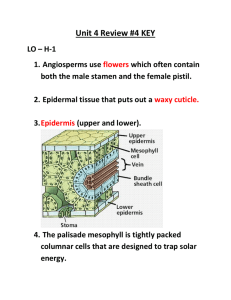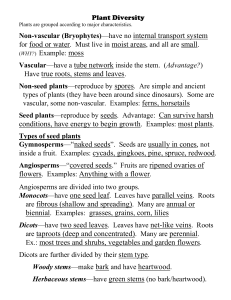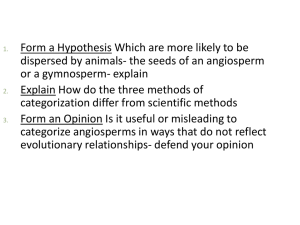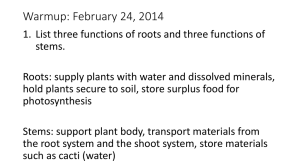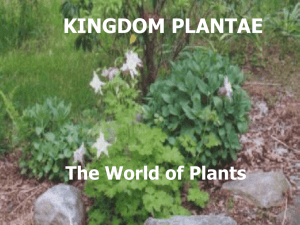Classifying Plants
advertisement
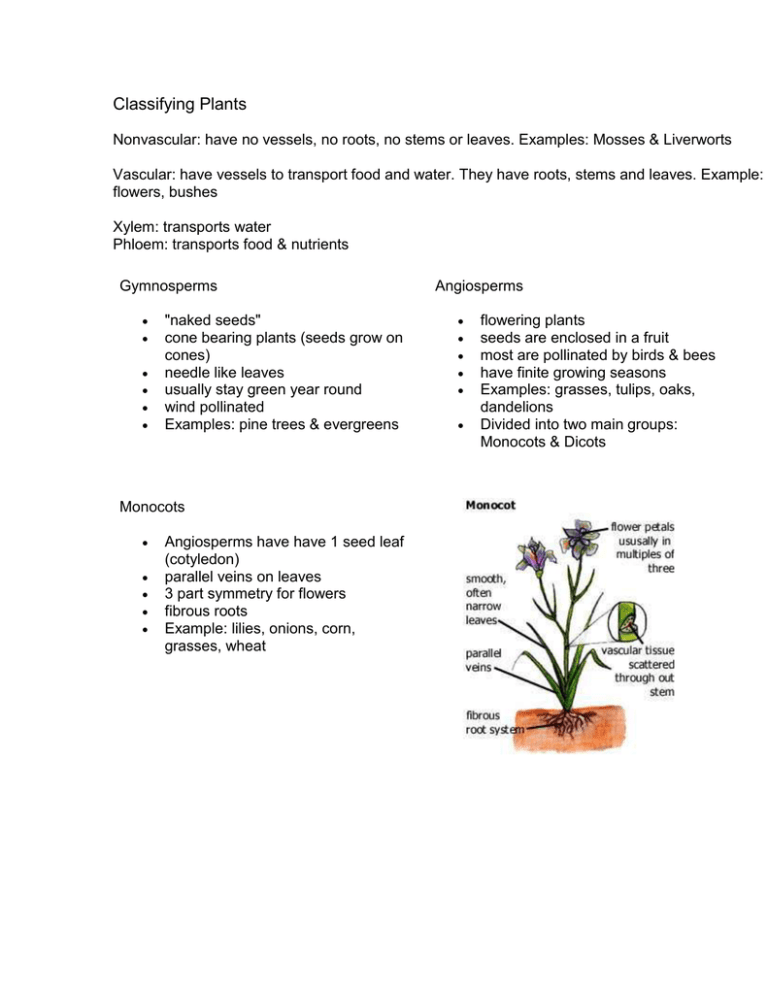
Classifying Plants Nonvascular: have no vessels, no roots, no stems or leaves. Examples: Mosses & Liverworts Vascular: have vessels to transport food and water. They have roots, stems and leaves. Example: G flowers, bushes Xylem: transports water Phloem: transports food & nutrients Gymnosperms "naked seeds" cone bearing plants (seeds grow on cones) needle like leaves usually stay green year round wind pollinated Examples: pine trees & evergreens Monocots Angiosperms have have 1 seed leaf (cotyledon) parallel veins on leaves 3 part symmetry for flowers fibrous roots Example: lilies, onions, corn, grasses, wheat Angiosperms flowering plants seeds are enclosed in a fruit most are pollinated by birds & bees have finite growing seasons Examples: grasses, tulips, oaks, dandelions Divided into two main groups: Monocots & Dicots Dicots Angiosperms that have 2 seed leaves (cotyledons) net veins on leaves flowers have 4-5 parts taproots Examples: trees and ornamental flowers Parts of the Plant Roots water and minerals are absorbed (taproots vs fibrous roots) also used to anchor the plant movement of water up to leaves is influenced by TRANSPIRATION Stems Support plant transport water through xylem transport nutrients through phloem a celery stalk soaked in food coloring will absorb the food coloring, you can see the xylem Two types of stems: herbacious and woody Leaves Photosynthetic organ of the plant, used to convert sunlight into food Photosynthesis Equation: Stomata: pores within the leaf that open to let CO2 in and O2 out. Guard cells open and clos Cuticle: waxy covering on leaf that prevents water loss Flower Reproductive organ of the plant Flowers are usually both male and female The male part of the flower is the STAMEN The female part of the flower is the PISTIL See your coloring sheet for more detail on flower anatomy Plant Reproduction Pollen is produced by the stamen. Pollen moves away from the plant via the wind or other pollinators (birds & bees) The pollen lands on the pistil of another plant and fertilizes the eggs within the ovary The flower petals fall off, the ovary develops into a FRUIT that encloses the seeds Fruits are dispersed in a variety of ways (wind, animals) Fruits are not always edible, anything with a seed inside can be considered a fruit (helicopte Asexual Reproduction in Plants Many plants can clone themselves, a process called VEGETATIVE PROPAGATION strawberry plants and other vine like plants send out runners, which grow into new plants some plant clippings will grow into new plants a Potato will grow into a new plant How Plants Grow Germination occurs when a seed sprouts (usually caused by changes of temperature and m Monocots have 1 seed leaf (cotyledon), Dicots have 2 seed leaves Perennials - live serval years, and reproduce many times, woody plants are perennials Annuals - a plant that completes its life cycle in one growing season (grows, flowers, reproduces and then dies) Biennials - takes two growing seasons to complete, it reproduces in the second growing season Plants grow only at their tips in regions called MERISTEMS PRIMARY GROWTH makes a plant taller at roots and stems SECONDARY GROWTH makes a plant wider, or adds woody tissue Tree Rings tell the age of a tree, each ring represents a growing season. The photo shows a through four growing seasons. The lighter thinner rings are winter periods. VASCULAR CAMBIUM: area of the tree that makes more xylem and phloem and forms the a

